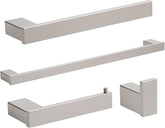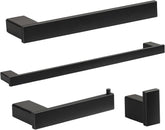Step-by-Step Guide: Installation Tutorial for American Standard Bathroom Faucets
During bathroom renovations or faucet replacements in the United States, many homeowners worry about installation mistakes due to unfamiliarity with the American standard plumbing system. In fact, as long as you choose a compatible product (such as KLABB bathroom faucets) and follow the steps, even beginners can complete the installation easily. Below, we will break down the entire installation process of bathroom faucets that meet American standards, combined with the characteristics of KLABB faucets, and also share practical tips for post-installation cleaning.
1. Pre-Installation Preparation: Confirm Compatibility and Gather Tools
1.1 Check Product Compatibility
Most KLABB bathroom faucets (such as single-hole and double-handle models) comply with the American standard plumbing interface (G1/2 universal thread). Before installation, you only need to confirm that the number of installation holes in the bathroom sink (single-hole/three-hole) matches the faucet. For example, KLABB single-hole faucets are suitable for 1 installation hole, while double-handle models require 3 holes (usually with a 4-inch hole spacing, which conforms to the common size of American bathroom countertops), no additional drilling or modification is needed.
1.2 Essential Tools and Accessories
Tools: Adjustable wrench, screwdriver, Teflon tape;
Accessories included with KLABB faucets: Leak-proof gaskets (suitable for the sealing needs of American-style pipes), installation manual (with diagrams for adapting to the American standard plumbing system). There is no need to purchase additional compatible parts.
2. Install KLABB Bathroom Faucet in 6 Steps (Compliant with American Standards)
2.1 Turn Off the Water Supply (Critical First Step)
Locate the American standard shut-off valve (usually a ball valve) under the bathroom sink, turn it clockwise until it is fully closed to prevent water leakage during installation. After closing, open the old faucet to drain any remaining water in the pipes and avoid splashing when removing the old faucet.
2.2 Remove the Old Faucet
Use an adjustable wrench to clamp the nut at the bottom of the old faucet and turn it counterclockwise to remove it. If it is rusted and hard to remove, drop a small amount of lubricant (such as WD-40) and wait for 5 minutes. After removal, wipe the countertop and pipe interfaces with a dry cloth to clean residual limescale. At this point, you can first use the KLABB vacuum hose to suck up dust in the gaps to prevent impurities from affecting the seal later.
2.3 Pre-Treat the New Faucet (KLABB-Specific Detail)
Take out theKLABB faucet, wrap 3-5 turns of Teflon tape around the threaded part of the water inlet (wrap clockwise to fit the threads), then put on the included leak-proof gasket (1.2mm thicker than ordinary gaskets, suitable for American high-pressure water supply to reduce the risk of water leakage). This step can greatly reduce the probability of water seepage later.
2.4 Fix the Faucet to the Countertop
Align the KLABB faucet with the installation hole and place it in position. Put the fixing nut on from the bottom of the countertop, first screw it by hand until it fits, then gently tighten it with an adjustable wrench (pay attention to the force to avoid damaging the countertop or the faucet base). The base of KLABB faucets is equipped with a non-slip pad, so no additional glue is needed, and it will not loosen easily after fixing.
Connect the Water Inlet Pipes
Locate the American standard hot and cold water inlet pipes (usually marked with red for hot water and blue for cold water), and connect them to the hot and cold water interfaces of the KLABB faucet respectively (the faucet is marked with "H" and "C" to avoid reverse connection). Tighten the interfaces with an adjustable wrench (the force should be "non-slip and non-leakage", no excessive force is needed).
Open the shut-off valve and let water flow slowly for 10 seconds to check if there is any water leakage at the interfaces. If there is slight water seepage, you can tighten the nut by another 1/4 turn. After confirming no water leakage, test whether the water flow of the faucet is smooth, and adjust the handle to confirm that the hot and cold water switching is normal. The ceramic valve core of KLABB faucets switches smoothly without jamming.
Post-Installation Cleaning: KLABB Vacuum Hose Comes in Handy
After installation, there may be residual dust or Teflon tape debris on the countertop and floor. At this time, use the KLABB vacuum hose (compatible with the interfaces of mainstream American vacuum cleaners), replace it with a slender suction head, which can reach into the gaps at the base of the faucet and around the pipes under the sink to easily suck up impurities. It is more efficient than wiping with a rag, and also prevents dust from falling into the pipes and affecting water quality.
According to the above steps, you can complete the installation of the KLABB bathroom faucet within 1 hour. No professional plumber is needed throughout the process, which not only saves installation costs but also ensures compatibility with the American standard plumbing system. If you encounter problems during installation, you can refer to the KLABB instruction manual or contact the brand's after-sales service. Using it with the vacuum hose allows you to achieve both installation and cleaning in one go.





